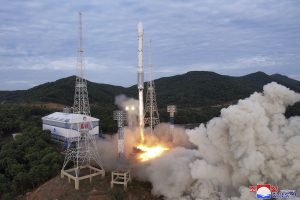North Korea attempted to put a military reconnaissance satellite into orbit on Thursday morning but failed, according to the state-run Korean Central News Agency (KCNA). It was the second failed attempt in three months. According to KCNA, North Korea will make a third try in October.
KCNA reported that the reconnaissance satellite, named Malligyong-1, was launched from the Sohae Satellite Launching Ground, which is located in Cholsan County of North Pyongan Province, aboard the Chollima-1 rocket at dawn on August 24.
This launch site has been used in the past for both missile and rocket launches. (A missile launch and a satellite launch use similar technology.)
“The flights of the first and second stages of the rocket were normal, but the launch failed due to an error in the emergency blasting system during the third-stage flight,” KCNA reported.
It added that “the cause of the relevant accident is not a big problem in aspect of the reliability of cascade engines and the system.”
“The NADA said that it would make clear in a short span of time the reason why the emergency blasting system was operated abnormally,” KCNA announcement said, referring to the country’s official space agency, the National Aerospace Development Administration.
The space agency will conduct a third launch “in October after thoroughly probing the reason and taking measures,” it added.
On May 31, North Korea made its first attempt to launch the reconnaissance satellite with the same name of Malligyong-1, which resulted in failure.
Rocket experts have interpreted Pyongyang’s statement to mean that there was an “accidental activation of the self-destruct system” in the third stage.
“The ‘emergency blasting system’ sounds somewhat weird in my ears,” Markus Schiller, a space technology analyst and CEO of ST Analytics in Munich, Germany, told The Diplomat on August 24.
“It seems reasonable to assume that they actually are referring to the self-destruct system,” he said.
There is another big question mark over the North’s statement. Pyongyang said the flights of the first and second stages of the rocket were normal, but the Japanese Ministry of Defense (MoD) released an analysis of the launch on August 24 stating that the rocket stages actually landed close to but outside all three areas that North Korea had identified in advance as drop zones for rocket stages and other residual rocket components.
“According to a graphic released by the Japanese MoD, the first stage and the shroud were overshooting their drop zones a little, while the second stage fell down more than 100 km short and west of the announced drop zone,” Schiller pointed out.
“This is too much to blame on crosswinds, I think, and it could either mean that the trajectory was a little off, or that the engines were not functioning as they should,” he said.
Schiller specifically pointed out one possible scenario: The first stage may have flown on a slightly lower angle than originally intended, and the second stage may have continued down that lower trajectory. Even if the second stage made a slight left turn at the correct time, its position would have shifted west due to the lower trajectory.
“All this could have occurred by minor deviations from the intended trajectory, but those could have proven fatal. Indeed, this might have triggered the self-destruction of the third stage at some point,” Schiller said.
Meanwhile, Tada Sho, a rocket expert and an associate professor of the High Energy Accelerator Research Organization in Tsukuba City in Japan, pointed out the designated drop zones for the detached rocket (essentially, an empty tank) are not the result of precision guidance. Detachment of each stage is essentially the process of separating and throwing away unnecessary things, and there is not a guidance system for these falling objects.
“So there is no problem even if it is slightly different than the expected point,” Tada said.
“If North Korea’s announcement is true, the previous launch had a problem with the second stage, but this time there was a problem with the third stage, so I think they are making progress,” he added.
One of the notable outcomes originating from North Korea’s failed second military satellite launch is that this brought about the first test case of the trilateral agreement reached by Japanese Prime Minister Kishida Fumio, South Korean President Yoon Suk-yeol and U.S. President Joe Biden at Camp David on August 18.
South Korea’s president ordered officials to share information on the North Korean satellite launch with Tokyo and Washington, following through on the trilateral pact and representing a recent thawing of ties between the two Northeast nations.

































